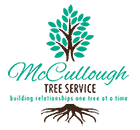By: Shelby McCullough| Published: June 8, 2024
Maintaining the health and beauty of your landscape requires a keen eye and knowledge about the condition of your trees. One crucial skill is identifying a dying tree before it becomes a hazard. This guide will help you understand the signs of a dying tree and what steps you can take to address the issue.
Understanding the Importance of Tree Health
Healthy trees provide numerous benefits, including shade, beauty, and improved air quality. However, when trees begin to die, they can pose significant risks to your property and safety. Identifying a dying tree early can prevent accidents and save other trees in your landscape from potential disease spread.

Key Signs of a Dying Tree
1. Leaf Color and Health
- Early Leaf Drop: If your tree is shedding leaves during the growing season, it could be a sign of stress.
- Discolored Leaves: Look for yellowing or browning leaves, especially if it’s not the autumn season.
- Sparse Foliage: Healthy trees should have a full canopy of leaves. Sparse or thinning foliage is a red flag.
2. Bark and Trunk Issues
- Peeling or Cracked Bark: The bark acts as a protective layer. Peeling or cracked bark indicates that the tree is struggling.
- Holes and Cankers: These could be signs of pests or diseases. Cankers, or sunken areas of dead bark, are particularly concerning.
- Soft or Brittle Wood: Poke the trunk with a screwdriver. If the wood is soft or brittle, the tree might be decaying internally.

3. Branch Condition
- Dead Branches: Look for dead branches that are dry and break easily.
- Fungal Growth: Mushrooms or other fungi growing on the trunk or branches often indicate internal decay.
- Branch Drop: If your tree regularly sheds large branches, it’s likely in decline.
What Causes a Tree to Die?
Understanding why trees die can help in preventing such issues. Here are common causes:
- Pest Infestation: Insects like beetles, borers, and caterpillars can damage a tree’s internal structure.
- Diseases: Fungal, bacterial, and viral infections can quickly spread and kill a tree.
- Environmental Stress: Drought, poor soil quality, and extreme weather can all take a toll on tree health.
- Physical Damage: Construction, landscaping, or storm damage can severely affect a tree’s ability to thrive.

Preventive Measures
1. Regular Inspections
- Routine Checks: Inspect your trees regularly for early signs of distress.
- Professional Assessment: Have a certified arborist evaluate your trees annually.
2. Proper Care
- Watering: Ensure your trees receive adequate water, especially during dry spells.
- Mulching: Use mulch to retain soil moisture and protect roots.
- Pruning: Proper pruning helps maintain tree health by removing diseased or dead branches.
When to Call a Professional
While some signs of a dying tree are obvious, others are more subtle. It’s crucial to know when to call in an expert:
- Large Dead Branches: If you notice large branches falling, it’s time for a professional evaluation.
- Structural Issues: Leaning trees or those with significant trunk damage need immediate attention.
- Disease and Pest Infestation: Professional treatment is often necessary to manage serious infections or infestations.
FAQ: Identifying and Managing a Dying Tree
Q: How can I tell if a tree is dead or just dormant?
A: Scratch the bark to see if there is green tissue beneath. If there’s no green, the tree might be dead.
Q: What should I do if my tree has a fungal infection?
A: Contact an arborist for an accurate diagnosis and treatment plan.
Q: Can a dying tree be saved?
A: Depending on the severity and cause of the decline, some trees can be saved with appropriate intervention.
Q: How often should I inspect my trees?
A: Conduct visual inspections every season and have a professional inspection annually.
Q: Is it necessary to remove a dying tree?
A: Yes, to prevent hazards and potential disease spread, dying trees should be professionally removed.
Conclusion
Identifying a dying tree early is critical to maintaining the health and safety of your landscape. Regular inspections, proper care, and timely professional intervention can save your trees and prevent potential hazards. Remember, a healthy tree today is a safer and more beautiful yard tomorrow. For professional tree care services, contact McCullough Tree Service for expert advice and assistance.

